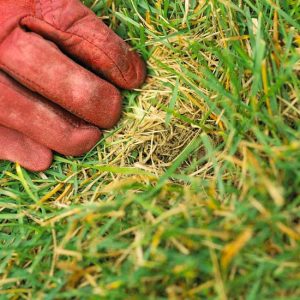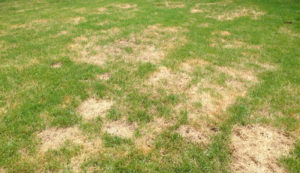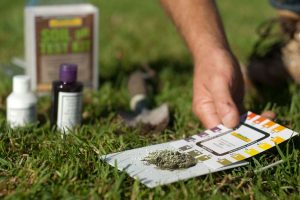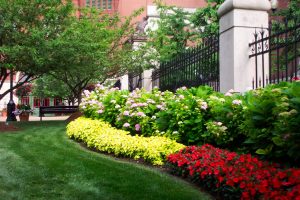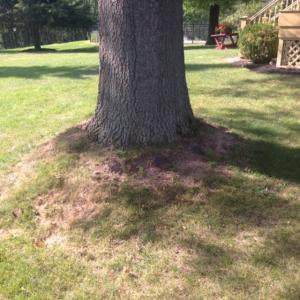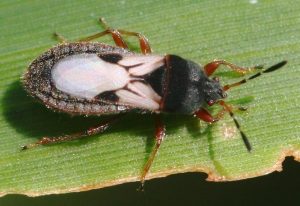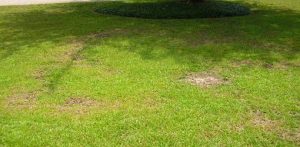Let’s face it. Summer is tough on lawns. You have grubs, chinch bugs, sod webworms, crabgrass, nutsedge, drought stress, and one of the worst problems, turf disease. Even with a beautiful, green lawn free of insects and weeds, turf disease can sneak up to destroy all of your hard work. Every lawn, no matter how… [Read More]
Lawn Tips – 7 Situations That Could Be Causing Brown Spots in Your Lawn!
The summer season can be tough on your lawn and sometimes you will notice brown spots in the grass. It could be a number of things so let’s go through the usual suspects… Heat and Drought Stress? Only getting a little rainfall combined with excessive temperatures can force your lawn into “dormancy” which is a… [Read More]
Fungus Is No Friend to Your Lawn. Learn How to Keep Your Lawn Disease Free…
Your lawn is no different than all living things it is prone to disease. Humans catch viruses but your lawn is affected by fungus. Listed are several common lawn diseases… Brown patch Dollar spot Fairy ring Fusarium blight Necrotic ring spot If you lawn becomes brown, yellow or filled with mushrooms one of these unique… [Read More]
The Benefits of Adding Lime to Your Lawn and When to Apply It…
When lawns are weedy, patchy in spots or turn yellow, it may be a sign that the pH balance of your yard is out of whack. One of the primary methods of correcting the problem is to add lime to your lawn to restore depleted nutrients and repair the damage. Liming a neglected lawn can… [Read More]
How to Prepare Your Lawn and Landscaping for a Long Winter Nap
Snow and ice can cause havoc on lawns and landscaping. In our cold winter climate take these steps to protect your plants, trees and shrubs from snow, ice, winds and winter temperatures… Fertilize For Future Growth Grass leaves grow much more slowly as the weather turns cool, but the grass roots and rhizomes continue to… [Read More]
Eco Friendly Tips For Keeping a Drought Tolerant Garden in the Midwest and Southeast Regions of the United States
Eco-friendly gardening is all about working with nature, not against it. The design can take on many looks depending on the site you have in mind. A wetland area will look different, for instance, than a miniature grassland prairie. The ideal eco-garden is made up of native species, and often becomes habitat for birds and… [Read More]
The Secret to Understanding Your Landscape is Knowing How to Handle Each of the Landscaping Layers!
We will try and describe here the astonishing array of ecosystems, plants, and elements (visual and structural) that make up your landscape. By being conscious of them and carefully considering them individually and collectively, you can assess your landscape and its needs with confidence. Your landscape can be a confusing place. however there is a… [Read More]
Landscaping Tips – How to Keep Compacted Soil From Threating the Health of Your Trees
Soil provides nourishment for the tree’s root system, so healthy soil is essential for a healthy tree! Make sure you’re planting your tree in the healthiest soil possible. Many trees on our property battle an unseen danger: compacted soil. That’s when the particles of the soil are packed together so tightly that air and water… [Read More]
Lawn & Landscaping Tips – How Do I Get Rid of Chinch Bugs?
Chinch bugs are small, true bugs (Hemiptera) that damage turf grasses There are a number of different species. Immature chinch bugs look like small, wingless adults and feed on the same plants. Chinch bugs cause irregular patches of dead or yellowed turf and are especially damaging during hot, dry summers following a dry spring. There… [Read More]
Fungal Diseases In Your Lawn? Here Are the Steps To Follow To Take Control Before It’s Too Late
If you suspect a fungal disease in your lawn, you should do the following… Test the Soil – Conducting a soil test can not only identify nutrient deficiencies that lead to stressed lawns and disease but sometimes can be used to diagnose the disease itself. Aerate – Loosen soil by aerating your lawn every year or two… [Read More]

